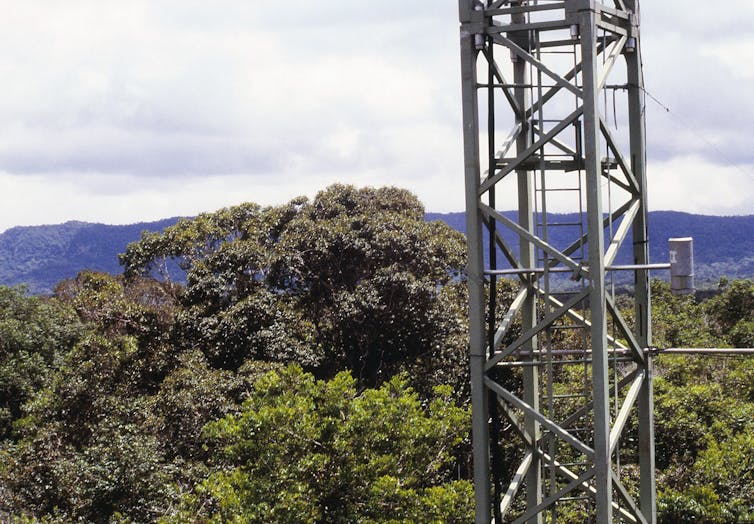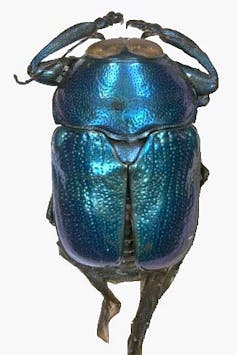Tiny treetop flowers foster incredible beetle biodiversity
- Written by Caroline S. Chaboo, Adjunct Professor in Insect Systematics, University of Nebraska-Lincoln
The Research Brief[1] is a short take on interesting academic work.
The big idea
Biologists have long known that rainforest treetops support a huge number of beetle species, but why these canopies are so rich in beetle diversity has remained a mystery[2]. New research by my colleague Susan Kirmse[3] and me shows that flowering trees play a critical role in maintaining this diversity, and that beetles may be among the most diverse pollinators in the animal kingdom.
We carried out a one-year study in a remote part of the Amazon rainforest in Venezuela. We used a specially built crane to collect a total of 6,698 adult beetles representing 859 species. These were gathered from 45 individual trees of 23 different tree species.
We were surprised to discover that the majority of these beetles - 647, or 75.3% of species found – were living on flowering trees[4]. In fact, 527 beetle species in 41 families were associated exclusively with flowers. Interestingly, the majority of these species – almost 60% – were exclusively found on trees that produce lots of small white flowers.
Overall, this discovery shows that flowering trees are likely among the most important drivers for maintaining the high diversity of beetles in rainforests. But this relationship goes both ways. Our study also suggests that beetles may be among the most underappreciated pollinators in tropical forests.
 Using a specialized crane, the team was able to collect beetles from the very top of the forest canopy.
Susan Kirmse, CC BY-ND[5]
Using a specialized crane, the team was able to collect beetles from the very top of the forest canopy.
Susan Kirmse, CC BY-ND[5]
Why it matters
Tropical rainforests are the very heart of Earth’s biodiversity. They harbor about 65% to 75% of all terrestrial species[6], including the most tree species and the most insects.
After finding such a tight relationship between beetles and flowering trees, we wondered: How many beetle species could be involved in pollination in the Amazon? Our study found an average of 26.35 unique beetle species for every species of tree. With an estimated 16,000 Amazonian tree species[7], this suggests that there might be more species of flower-visiting beetles than any other insects on Earth, potentially surpassing by far the 20,000 species of bees[8] and the 19,000 species of butterflies[9].
Our study shows that flowering tree species play an important role as diversity hotspots in tropical rainforest canopies[10]. For policymakers and biologists hoping to preserve or restore rainforests, promoting the cultivation of trees and other plants – especially those with lots of small white flowers that beetles love – could help to maintain species-rich communities. Flowers are a very important resource, providing food and shelter for thousands of insects in addition to beetles. Thus, preserving plant diversity or selecting many different indigenous tree species for reforestation can enhance the diversity of insects.
 Beetles like the Griburius auricapillus are just some of the hundreds of species that can be found in treetops.
Susan Kirmse, CC BY-ND[11]
Beetles like the Griburius auricapillus are just some of the hundreds of species that can be found in treetops.
Susan Kirmse, CC BY-ND[11]
What still isn’t known
Our research was the first to describe this tight relationship between beetles and rainforest trees, especially with trees that produce thousands of small, simple flowers. But how this association came to be is still unclear.
Many of the beetle species were found only on trees with this particular type of flower. The trees get an obvious benefit: pollination. But what specifically these trees offer to the beetles requires further study. The simpler flowers are easier for beetles to access[12], but is the appeal food, like petals, pollen or nectar? Or maybe a home to find mates or lay eggs for the young to grow?
[You’re smart and curious about the world. So are The Conversation’s authors and editors. You can get our highlights each weekend[13].]
What’s next
To fight the worldwide rapid declines in insect diversity[14], researchers and conservationists must understand the ecological connections between insects and their food plants. Long-term studies[15], particularly in research plots like the one we used in Venezuela, allow researchers to collect layers of information that help unravel the complexity of diversity.
Yet such sites rely on political interest and stability. Political instability in Venezuela[16] is preventing our fieldwork from continuing at the Venezuela plot.
While we can’t return to our study site in Venezuela, it is clear that researchers must work together to understand the mysteries of life on Earth. But biologists are racing the clock as large rainforests are destroyed forever.
References
- ^ Research Brief (theconversation.com)
- ^ remained a mystery (doi.org)
- ^ Susan Kirmse (www.researchgate.net)
- ^ were living on flowering trees (doi.org)
- ^ CC BY-ND (creativecommons.org)
- ^ 65% to 75% of all terrestrial species (doi.org)
- ^ 16,000 Amazonian tree species (doi.org)
- ^ 20,000 species of bees (doi.org)
- ^ 19,000 species of butterflies (doi.org)
- ^ diversity hotspots in tropical rainforest canopies (doi.org)
- ^ CC BY-ND (creativecommons.org)
- ^ simpler flowers are easier for beetles to access (doi.org)
- ^ You can get our highlights each weekend (theconversation.com)
- ^ declines in insect diversity (doi.org)
- ^ Long-term studies (doi.org)
- ^ Political instability in Venezuela (www.state.gov)
Authors: Caroline S. Chaboo, Adjunct Professor in Insect Systematics, University of Nebraska-Lincoln
Read more https://theconversation.com/tiny-treetop-flowers-foster-incredible-beetle-biodiversity-150924

